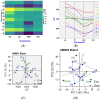Integrating BLUP, AMMI, and GGE Models to Explore GE Interactions for Adaptability and Stability of Winter Lentils (Lens culinaris Medik.)
- PMID: 37299058
- PMCID: PMC10255267
- DOI: 10.3390/plants12112079
Integrating BLUP, AMMI, and GGE Models to Explore GE Interactions for Adaptability and Stability of Winter Lentils (Lens culinaris Medik.)
Abstract
Lentil yield is a complicated quantitative trait; it is significantly influenced by the environment. It is crucial for improving human health and nutritional security in the country as well as for a sustainable agricultural system. The study was laid out to determine the stable genotype through the collaboration of G × E by AMMI and GGE biplot and to identify the superior genotypes using 33 parametric and non-parametric stability statistics of 10 genotypes across four different conditions. The total G × E effect was divided into two primary components by the AMMI model. For days to flowering, days to maturity, plant height, pods per plant, and hundred seed weight, IPCA1 was significant and accounted for 83%, 75%, 100%, and 62%, respectively. Both IPCA1 and IPCA2 were non-significant for yield per plant and accounted for 62% of the overall G × E interaction. An estimated set of eight stability parameters showed strong positive correlations with mean seed yield, and these measurements can be utilized to choose stable genotypes. The productivity of lentils has varied greatly in the environment, ranging from 786 kg per ha in the MYM environment to 1658 kg per ha in the ISD environment, according to the AMMI biplot. Three genotypes (G8, G7, and G2) were shown to be the most stable based on non-parametric stability scores for grain yield. G8, G7, G2, and G5 were determined as the top lentil genotypes based on grain production using numerical stability metrics such as Francis's coefficient of variation, Shukla stability value (σi2), and Wrick's ecovalence (Wi). Genotypes G7, G10, and G4 were the most stable with the highest yield, according to BLUP-based simultaneous selection stability characteristics. The findings of graphic stability methods such as AMMI and GGE for identifying the high-yielding and stable lentil genotypes were very similar. While the GGE biplot indicated G2, G10, and G7 as the most stable and high-producing genotypes, AMMI analysis identified G2, G9, G10, and G7. These selected genotypes would be used to release a new variety. Considering all the stability models, such as Eberhart and Russell's regression and deviation from regression, additive main effects, multiplicative interactions (AMMI) analysis, and GGE, the genotypes G2, G9, and G7 could be used as well-adapted genotypes with moderate grain yield in all tested environments.
Keywords: AMMI; BLUP; GGE biplot; lentil; non-parametric and parametric stability indices; regression and deviation from regression.
Conflict of interest statement
The authors declare no conflict of interest.
Figures









Similar articles
-
Genotype-by-environment interaction and stability analysis of grain yield of bread wheat (Triticum aestivum L.) genotypes using AMMI and GGE biplot analyses.Heliyon. 2024 Jun 14;10(12):e32918. doi: 10.1016/j.heliyon.2024.e32918. eCollection 2024 Jun 30. Heliyon. 2024. PMID: 38988541 Free PMC article.
-
Genotype x environment interaction and yield stability of soybean (Glycine max l.) genotypes in multi-environment trials (METs) in Nigeria.Heliyon. 2024 Sep 18;10(19):e38097. doi: 10.1016/j.heliyon.2024.e38097. eCollection 2024 Oct 15. Heliyon. 2024. PMID: 39398076 Free PMC article.
-
AMMI and GGE biplot analyses of Bambara groundnut [Vigna subterranea (L.) Verdc.] for agronomic performances under three environmental conditions.Front Plant Sci. 2023 Jan 20;13:997429. doi: 10.3389/fpls.2022.997429. eCollection 2022. Front Plant Sci. 2023. PMID: 36743535 Free PMC article.
-
Assessing yield performance and stability of local sorghum genotypes: A methodological framework combining multi-environment trials and participatory multi-trait evaluation.Heliyon. 2024 Feb 7;10(4):e25114. doi: 10.1016/j.heliyon.2024.e25114. eCollection 2024 Feb 29. Heliyon. 2024. PMID: 38370242 Free PMC article. Review.
-
Stability Indices to Deciphering the Genotype-by-Environment Interaction (GEI) Effect: An Applicable Review for Use in Plant Breeding Programs.Plants (Basel). 2022 Feb 2;11(3):414. doi: 10.3390/plants11030414. Plants (Basel). 2022. PMID: 35161396 Free PMC article. Review.
Cited by
-
Genotype-by-environment interaction and stability analysis of grain yield of bread wheat (Triticum aestivum L.) genotypes using AMMI and GGE biplot analyses.Heliyon. 2024 Jun 14;10(12):e32918. doi: 10.1016/j.heliyon.2024.e32918. eCollection 2024 Jun 30. Heliyon. 2024. PMID: 38988541 Free PMC article.
-
Evaluation of yield attributes and bioactive phytochemicals of twenty amaranth genotypes of Bengal floodplain.Heliyon. 2023 Aug 30;9(9):e19644. doi: 10.1016/j.heliyon.2023.e19644. eCollection 2023 Sep. Heliyon. 2023. PMID: 37809463 Free PMC article.
-
Assessing agronomic performance, chocolate spot resistance, and heat tolerance for diverse Vicia faba genotypes under varying environmental conditions.Sci Rep. 2024 Apr 22;14(1):9224. doi: 10.1038/s41598-024-59079-3. Sci Rep. 2024. PMID: 38649406 Free PMC article.
-
Exploring Genetics by Environment Interactions in Some Rice Genotypes across Varied Environmental Conditions.Plants (Basel). 2023 Dec 26;13(1):74. doi: 10.3390/plants13010074. Plants (Basel). 2023. PMID: 38202383 Free PMC article.
-
Identification of heterosis and combining ability in the hybrids of male sterile and restorer sorghum [Sorghum bicolor (L.) Moench] lines.PLoS One. 2024 Jan 2;19(1):e0296416. doi: 10.1371/journal.pone.0296416. eCollection 2024. PLoS One. 2024. PMID: 38166022 Free PMC article.
References
-
- Negussie T., Pretorius Z.A. Lentil Rust: Present Status and Future Prospects. Crop Prot. 2012;32:119–128. doi: 10.1016/j.cropro.2011.11.004. - DOI
-
- Parihar A.K., Basandrai A.K., Saxena D.R., Kushwaha K.P.S., Chandra S., Sharma K., Singha K.D., Singh D., Lal H.C., Gupta S. Biplot Evaluation of Test Environments and Identification of Lentil Genotypes with Durable Resistance to Fusarium Wilt in India. Crop Pasture Sci. 2017;68:1024–1030. doi: 10.1071/CP17258. - DOI
-
- Arumuganathan K., Earle E.D. Nuclear DNA Content of Some Important Plant Species. Plant Mol. Biol. Report. 1991;9:208–218. doi: 10.1007/BF02672069. - DOI
-
- Shrestha R., Rizvi A.H., Sarker A., Darai R., Paneru R.B., Vandenberg A., Singh M. Genotypic Variability and Genotype× Environment Interaction for Iron and Zinc Content in Lentil under Nepalese Environments. Crop Sci. 2018;58:2503–2510. doi: 10.2135/cropsci2018.05.0321. - DOI
-
- Grusak M.A. Nutritional and Health-Beneficial Quality. Lentil Bot. Prod. Uses. 2009;1418:368.
LinkOut - more resources
Full Text Sources

